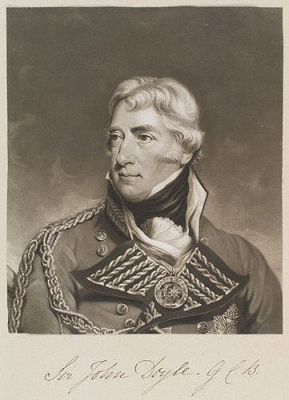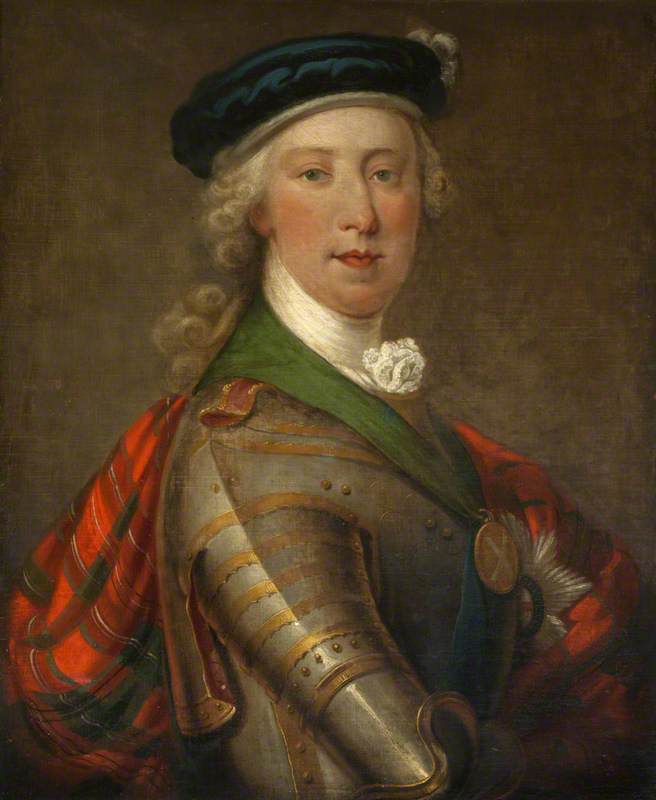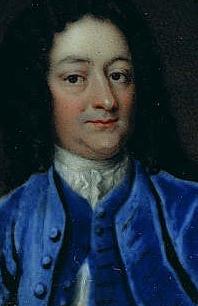|
John Mordaunt (British Army Officer)
General Sir John Mordaunt (1697 – 23 October 1780) was a British soldier and Whig politician, the son of Lieutenant-General Harry Mordaunt and Margaret Spencer. He was best known for his command of the Raid on Rochefort which ended in failure and his subsequent court-martial. Cleared on a technicality, he was nonetheless barred from holding further military command. Early career Mordaunt entered the army in 1721 and was promoted captain in George Wade's Regiment of Dragoon Guards in 1726. He became a lieutenant-colonel in the 3rd Foot Guards in 1731. He entered Parliament for Pontefract in 1730, for which he sat until 1734, and was then member for Whitchurch 1735–1741 and Cockermouth 1741–1768. In Parliament he was a steadfast Whig and supporter of Robert Walpole. In 1739 he became a founding governor of the Foundling Hospital. On 18 December 1742 Mordaunt was promoted to the rank of full colonel of the Royal Regiment of Ireland, which was sent in 1744 to prot ... [...More Info...] [...Related Items...] OR: [Wikipedia] [Google] [Baidu] |
Allan Ramsay (artist)
Allan Ramsay (13 October 171310 August 1784) was a prominent Scottish portrait-painter. Life and career Ramsay was born in Edinburgh, Scotland, the eldest son of Allan Ramsay, poet and author of ''The Gentle Shepherd''. From the age of twenty he studied in London under the Swedish painter Hans Hysing, and at the St. Martin's Lane Academy; leaving in 1736 for Rome and Naples Naples (; it, Napoli ; nap, Napule ), from grc, Νεάπολις, Neápolis, lit=new city. is the regional capital of Campania and the third-largest city of Italy, after Rome and Milan, with a population of 909,048 within the city's adminis ..., where he worked for three years under Francesco Solimena and Imperiali (Francesco Fernandi). On his return in 1738 to the British Isles, he first settled in Edinburgh, attracting attention by his head of Duncan Forbes of Culloden (judge, born 1685), Duncan Forbes of Culloden and his full-length portrait of the Archibald Campbell, 3rd Duke of Argyll, Du ... [...More Info...] [...Related Items...] OR: [Wikipedia] [Google] [Baidu] |
Colonel
Colonel (abbreviated as Col., Col or COL) is a senior military officer rank used in many countries. It is also used in some police forces and paramilitary organizations. In the 17th, 18th and 19th centuries, a colonel was typically in charge of a regiment in an army. Modern usage varies greatly, and in some cases, the term is used as an honorific title that may have no direct relationship to military service. The rank of colonel is typically above the rank of lieutenant colonel. The rank above colonel is typically called brigadier, brigade general or brigadier general. In some smaller military forces, such as those of Monaco or the Vatican, colonel is the highest rank. Equivalent naval ranks may be called captain or ship-of-the-line captain. In the Commonwealth's air force ranking system, the equivalent rank is group captain. History and origins By the end of the late medieval period, a group of "companies" was referred to as a "column" of an army. According to Raymond Ol ... [...More Info...] [...Related Items...] OR: [Wikipedia] [Google] [Baidu] |
War Of The Austrian Succession
The War of the Austrian Succession () was a European conflict that took place between 1740 and 1748. Fought primarily in Central Europe, the Austrian Netherlands, Italy, the Atlantic and Mediterranean, related conflicts included King George's War in North America, the War of Jenkins' Ear, the First Carnatic War and the First Silesian War, First and Second Silesian Wars. Its pretext was the right of Maria Theresa to succeed her father Emperor Charles VI as ruler of the Habsburg monarchy. Kingdom of France, France, Kingdom of Prussia, Prussia and Electorate of Bavaria, Bavaria saw it as an opportunity to challenge Habsburg power, while Maria Theresa was backed by Kingdom of Great Britain, Britain, the Dutch Republic and Electorate of Hanover, Hanover, collectively known as the Pragmatic Sanction of 1713, Pragmatic Allies. As the conflict widened, it drew in other participants, among them History of Spain (1700–1810), Spain, Kingdom of Sardinia, Sardinia, Electorate of Saxony, S ... [...More Info...] [...Related Items...] OR: [Wikipedia] [Google] [Baidu] |
Knight Companion Of The Order Of The Bath (1725–1815)
The Most Honourable Order of the Bath is a British order of chivalry founded by George I on 18 May 1725. The name derives from the elaborate medieval ceremony for appointing a knight, which involved bathing (as a symbol of purification) as one of its elements. The knights so created were known as "Knights of the Bath". George I "erected the Knights of the Bath into a regular Military Order". He did not (as is commonly believed) revive the Order of the Bath, since it had never previously existed as an Order, in the sense of a body of knights who were governed by a set of statutes and whose numbers were replenished when vacancies occurred. The Order consists of the Sovereign (currently King Charles III), the Great Master (currently vacant) and three Classes of members: *Knight Grand Cross ( GCB) ''or'' Dame Grand Cross ( GCB) *Knight Commander ( KCB) ''or'' Dame Commander ( DCB) *Companion ( CB) Members belong to either the Civil or the Military Division.''Statutes'' 1925, a ... [...More Info...] [...Related Items...] OR: [Wikipedia] [Google] [Baidu] |
Battle Of Lauffeld
The Battle of Lauffeld, variously known as Lafelt, Laffeld, Lawfeld, Lawfeldt, Maastricht, or Val, took place on 2 July 1747, between Tongeren in modern Belgium, and the Dutch city of Maastricht. Part of the War of the Austrian Succession, a French army of 80,000 under Marshal Saxe defeated a Pragmatic Army of 120,000, led by the Duke of Cumberland. Arguably the most talented general of his generation, Saxe conquered much of the Austrian Netherlands between 1744 to 1746 although he failed to achieve decisive victory. In the spring of 1747, Cumberland planned an offensive to retake Antwerp but was forced to fall back when the French threatened to cut him off from his supply base at Maastricht. When the two armies met at Lauffeld, a series of mistakes by Cumberland compromised his position and only counterattacks by the Allied cavalry prevented a serious defeat. The battle ended Allied hopes of regaining lost ground and Saxe captured Bergen op Zoom in September, then Maastricht ... [...More Info...] [...Related Items...] OR: [Wikipedia] [Google] [Baidu] |
12th Royal Lancers
The 12th (Prince of Wales's) Royal Lancers was a cavalry regiment of the British Army first formed in 1715. It saw service for three centuries, including the First World War and the Second World War. The regiment survived the immediate post-war reduction in forces, but was slated for reduction in the 1957 Defence White Paper, and was amalgamated with the 9th Queen's Royal Lancers to form the 9th/12th Royal Lancers (Prince of Wales's) in 1960. History Early wars The regiment of dragoons was raised in Reading by Brigadier-General Phineas Bowles as the Phineas Bowles's Regiment of Dragoons in July 1715 as part of the response to the Jacobite rebellion. It was employed escorting prisoners to London later in the year. In 1718, the regiment was placed on the Irish establishment and posted to Ireland, where it remained for 75 years. In 1751, the regiment was officially styled the 12th Dragoons. In 1768, King George III bestowed the badge of the three ostrich feathers and the motto ... [...More Info...] [...Related Items...] OR: [Wikipedia] [Google] [Baidu] |
Major-general
Major general (abbreviated MG, maj. gen. and similar) is a military rank used in many countries. It is derived from the older rank of sergeant major general. The disappearance of the "sergeant" in the title explains the apparent confusion of a lieutenant general outranking a major general, whereas a major outranks a lieutenant. In the Commonwealth and in the United States, when appointed to a field command, a major general is typically in command of a division consisting of around 6,000 to 25,000 troops (several regiments or brigades). It is a two-star rank that is subordinate to the rank of lieutenant general and senior to the rank of brigadier or brigadier general. In the Commonwealth, major general is equivalent to the navy rank of rear admiral. In air forces with a separate rank structure (Commonwealth), major general is equivalent to air vice-marshal. In some countries including much of Eastern Europe, major general is the lowest of the general officer ranks, with no ... [...More Info...] [...Related Items...] OR: [Wikipedia] [Google] [Baidu] |
Charles Edward Stuart
Charles Edward Louis John Sylvester Maria Casimir Stuart (20 December 1720 – 30 January 1788) was the elder son of James Francis Edward Stuart, grandson of James II and VII, and the Stuart claimant to the thrones of England, Scotland and Ireland from 1766 as Charles III. During his lifetime, he was also known as "the Young Pretender" and "the Young Chevalier"; in popular memory, he is known as Bonnie Prince Charlie. Born in Rome to the exiled Stuart court, he spent much of his early and later life in Italy. In 1744, he travelled to France to take part in a planned invasion to restore the Stuart monarchy under his father. When the French fleet was partly wrecked by storms, Charles resolved to proceed to Scotland following discussion with leading Jacobites. This resulted in Charles landing by ship on the west coast of Scotland, leading to the Jacobite rising of 1745. The Jacobite forces under Charles initially achieved several victories in the field, including the Battle of ... [...More Info...] [...Related Items...] OR: [Wikipedia] [Google] [Baidu] |
Battle Of Culloden
The Battle of Culloden (; gd, Blàr Chùil Lodair) was the final confrontation of the Jacobite rising of 1745. On 16 April 1746, the Jacobite army of Charles Edward Stuart was decisively defeated by a British government force under Prince William Augustus, Duke of Cumberland, on Drummossie Moor near Inverness in the Scottish Highlands. It was the last pitched battle fought on British soil. Charles was the eldest son of James Stuart, the exiled Stuart claimant to the British throne. Believing there was support for a Stuart restoration in both Scotland and England, he landed in Scotland in July 1745: raising an army of Scots Jacobite supporters, he took Edinburgh by September, and defeated a British government force at Prestonpans. The government recalled 12,000 troops from the Continent to deal with the rising: a Jacobite invasion of England reached as far as Derby before turning back, having attracted relatively few English recruits. The Jacobites, with limited French mi ... [...More Info...] [...Related Items...] OR: [Wikipedia] [Google] [Baidu] |
Prince William Augustus, Duke Of Cumberland
Prince William Augustus, Duke of Cumberland (15 April 1721 Old_Style_and_New_Style_dates">N.S..html" ;"title="Old_Style_and_New_Style_dates.html" ;"title="/nowiki> N.S.">Old_Style_and_New_Style_dates.html"_;"title="/nowiki>Old_Style_and_New_Style_dates">N.S./nowiki>_–_31_October_1765)_was_the_third_and_youngest_son_of_George_II_of_Great_Britain.html" ;"title="Old Style and New Style dates">N.S.">Old_Style_and_New_Style_dates.html" ;"title="/nowiki>N.S./nowiki>_–_31_October_1765)_was_the_third_and_youngest_son_of_George_II_of_Great_Britain">King_George_II_of_N.S./nowiki>_–_31_October_1765)_was_the_third_and_youngest_son_of_George_II_of_Great_Britain">King_George_II_of_Kingdom_of_Great_Britain">Great_Britain_and_Kingdom_of_Ireland.html" "title="Kingdom_of_Great_Britain.html" "title="Old Style and New Style dates">N.S./nowiki> – 31 October 1765) was the third and youngest son of George II of Great Britain">King George II of Kingdom of Great Britain">Great Britain and King ... [...More Info...] [...Related Items...] OR: [Wikipedia] [Google] [Baidu] |
Edinburgh
Edinburgh ( ; gd, Dùn Èideann ) is the capital city of Scotland and one of its 32 Council areas of Scotland, council areas. Historically part of the county of Midlothian (interchangeably Edinburghshire before 1921), it is located in Lothian on the southern shore of the Firth of Forth. Edinburgh is Scotland's List of towns and cities in Scotland by population, second-most populous city, after Glasgow, and the List of cities in the United Kingdom, seventh-most populous city in the United Kingdom. Recognised as the capital of Scotland since at least the 15th century, Edinburgh is the seat of the Scottish Government, the Scottish Parliament and the Courts of Scotland, highest courts in Scotland. The city's Holyrood Palace, Palace of Holyroodhouse is the official residence of the Monarchy of the United Kingdom, British monarchy in Scotland. The city has long been a centre of education, particularly in the fields of medicine, Scots law, Scottish law, literature, philosophy, the sc ... [...More Info...] [...Related Items...] OR: [Wikipedia] [Google] [Baidu] |
Battle Of Falkirk (1746)
The Battle of Falkirk Muir (Scottish Gaelic: ''Blàr na h-Eaglaise Brice''), also known as the Battle of Falkirk, took place on 17 January 1746 during the Jacobite rising of 1745. Although it resulted in a Jacobite victory, their inability to take advantage meant it ultimately had little impact on the campaign. Following their withdrawal from England in December 1745, the Jacobite army besieged Stirling Castle in early January. One of the strongest positions in Scotland, they made little progress and government forces under Henry Hawley advanced north from Edinburgh to relieve it. He reached Falkirk on 15 January but was taken by surprise when the Jacobites attacked late in the afternoon of 17 January. Fought in failing light and heavy snow, Hawley's left wing was routed but his right held firm and for a while both sides believed themselves to have been defeated. As a result of this confusion, the Jacobites failed to follow up their victory, leading to bitter disputes over r ... [...More Info...] [...Related Items...] OR: [Wikipedia] [Google] [Baidu] |
_RMG_RV6425_(cropped).jpg)






